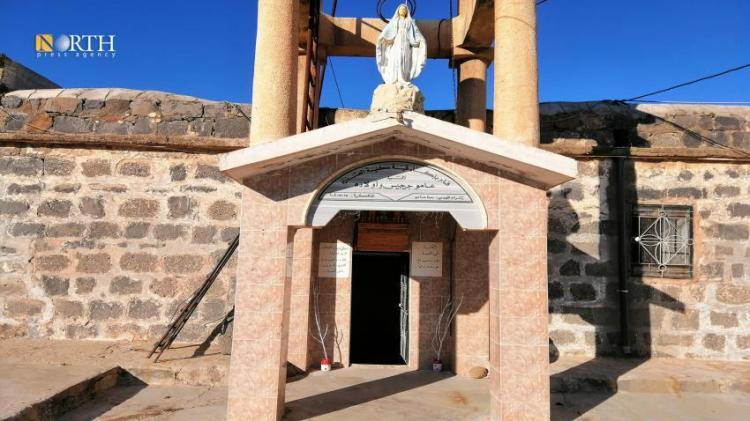Derik – North-Press Agency
Reem Chamoun – Charbel Hanou
A large number of Syriacs live in the city of Derik, in the far northeast of Syria, but only a few of them speak the Syriac language. Some attribute this to immigration as well as the lack of interest of some residents in their mother tongue, unlike in the cities of Qamishli and Tirbespi, in which a large percentage of Syriacs speak their language.
The proportion of Syriacs in the city of Derik exceeds 55% of the total number of Christians in the city, while the percentage of Syriacs speaking their language is less than 10%, according to the Syriac Orthodox Church in the city of Derik.
Uneven spread
The cities of Qamishli and Tirbespi are considered among the cities in the Jazira region which preserve the spoken Syriac language the most, and in these cities the proportion of those who speak the language exceeds 90% of the total Syriac population. Derik's comparatively low percentage is due to parents' lack of interest in teaching the language to their children.
21-year-old Lydia Murad blames the elderly in Derik, who did not try to preserve their mother tongue, but rather spoke Arabic with their children.
She told North-Press, "Syriac language classes in schools were elective classes similar to sports or drawing, and did not get serious attention from the residents or the children themselves."
Now, even with the spread of Syriac institutions in Derik, Murad says that "it is difficult for the Syriac language to spread in the city", but she still hopes to learn Syriac to teach it to her children in the future.
Syriacs between two periods
The Syrian government used to allow Syriac language classes in their schools, but Syriac activists say that these classes were limited to prayers and practicing religious rituals in churches.
The Autonomous Administration in North and East Syria started preparing and teaching curricula in Arabic, Kurdish, and Syriac. The Olaf Taw Foundation, established in 2016, supervised the preparation of an academic curriculum and training teachers in the Syriac language, but some differences, including political ones, affected the spread of the curriculum and language learning among residents.
49-year-old Ephrem Isaac, a Syriac resident of Derik, told North-Press: “The Syriacs who lived in Derik after the Seyfo massacres (the genocide of the Assyrian population by the Ottoman Empire in the 1920s) migrated from the villages of Azakh and Ain Ward, and spoke Arabic in their villages. Only a small percent of Syriacs who inhabited Derik spoke Syriac in their villages of origin and preserved it here.”
He adds: "In that period, no institution concerned with the Syriac language was established, so there was no interest in learning the language. But by 1935, private schools affiliated with the Syriac Church began to spread in the region and offered special classes for teaching Syriac within the school curricula. It was not a spoken language, rather, schools worked to teach ritual language and prayers."
Isaac says that now the Syriacs in Derik feel that they are losing something original which connects them to their land, and losing a Semitic language. Because of this, they have started speaking it in light of the establishment of the Syriac Cultural Association, which publishes the spoken Syriac language through cultural seminars. Now, after the establishment of the Olaf Taw Foundation, it has started teaching the Syriac spoken language in schools. "I hope the next generation preserves and transmits its original language to future generations," he said.
Derik-born Janet Youssef said that she was not fluent in the spoken Syriac language previously, but learned it after she married and moved to Qamishli, mastering it after mixing with her neighbors.
Youssef, a mother of three boys and two girls, added that she taught her children their language, and now tries to get her parents speak it in Derik.
"In Derik, there are few people who speak Syriac, but here all Syriacs speak Syriac. I was able to convey the language to my children so that they could master it better in schools and be aware of their mother tongue, which we were deprived of when we were young," she said.
Olaf Taw Foundation
Galen Issa, co-chair of the Olaf Taw Foundation, an institution concerned with the dissemination of the Syriac language, said that the language in Derik's schools is a liturgical language from the Qara Bashi curriculum, and the Syriac class was set at the last time of the official school hours. The Syrian government previously prohibited the circulation of any non-Arabic language in cities.
He added: "In Qamishli and Tirbespi, the Syriac language spread greatly due to Syriac cultural activities that existed and still exist, such as the Syriac Song Festival and the Syriac Language Festival, in addition to the great interest it received from the residents. Most of the bishops left the city of Qamishli towards serving the church worldwide."
For four years, the Olaf Taw Foundation has been working on training female teachers to teach the Syriac language in schools, and so far 15 teachers who have mastered the Syriac language have graduated. They are teaching in the Autonomous Administration schools in addition to teachers who teaching in church private schools.
Issa continues, "Currently we are teaching approximately 70 children from Jazira region the rules of the Syriac language via online lessons, in light of procedures to prevent the outbreak of the coronavirus. In these lessons, the teacher speaks the spoken language and the student tries to respond in the same language as well, and in this procedure, the student learns the Syriac standard language in addition to the spoken one.”

